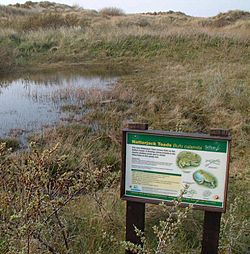Sefton Coast facts for kids
| Site of Special Scientific Interest | |
 |
|
| Area of Search | Merseyside |
|---|---|
| Coordinates | 53°35′06″N 3°03′40″W / 53.585°N 3.061°W |
| Interest | Biological and Geological |
| Area | 4605.32 hectares, 11,380 acres (46,100,000 m2) |
| Notification | 16 August 2000 |
The Sefton Coast is a special place along the coast of Merseyside, England. It stretches for about 12 miles (20 km) between Southport and Waterloo. This area is known as a Site of Special Scientific Interest (SSSI) because it has unique plants, animals, and geological features. It's a fantastic spot to explore nature and see some rare creatures!
Contents
Exploring Sefton Coast
The Sefton Coast is a very important natural area. It covers a huge space, about 4,605 hectares, which is like 11,380 football fields! This whole coastline is carefully looked after as a Special Area of Conservation (SAC). This means it's protected because it's home to many important wildlife habitats. The Sefton Coast Partnership helps manage and protect this amazing place.
Home to Amazing Wildlife
The Sefton Coast is bursting with life! You can find many different kinds of plants and animals here. Some of the special plants include beautiful grass of Parnassus and various wild orchids. It's also a great place for rare butterflies to flutter around.
This coast is a safe home for several unique animals:
- Sand lizards: These are rare lizards that love the sandy dunes.
- Natterjack toads: These special toads are found in only a few places in England.
- Waders: These are birds that like to feed in the shallow water along the shore.
Formby Point and Red Squirrels
Further north along the coast, you'll find Formby Point. This area has lovely pinewoods and sandy dunes. It's managed by the National Trust, an organization that protects important places in the UK.
The pine woods at Victoria Road, near Formby, are a special reserve for the red squirrel. These cute squirrels are on the endangered species list, which means they are at risk of disappearing. Formby is one of the few places in Britain where you can still see red squirrels. However, they are facing a threat from the grey squirrel, which is not native to the UK.
The Famous Natterjack Toads
Formby is especially famous for its Natterjack toads. This is one of only a few places in England where these toads successfully breed. If you visit in the evening, especially in spring, you might hear the male toads singing! Their loud, distinctive song is sometimes called the 'Bootle Organ' by local people.
Natterjack Toad Reproduction
In spring, male natterjack toads gather at the edges of shallow pools in the dune slacks. These are wet dips between sand dunes. They sing loudly to attract a mate. The Sefton Coast and Countryside Service works hard to make sure these pools don't dry up or get overgrown. This way, they are ready every spring for the toads' important breeding season.
Art on the Beach
The Sefton Coast also features a famous art installation at Crosby Beach. It's called Another Place and was created by the artist Antony Gormley. This artwork includes 100 life-sized statues of human figures. They are spread out along the beach, looking out towards the sea. It's a really cool and thought-provoking sight!

